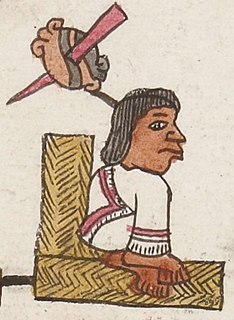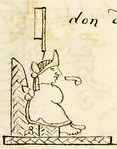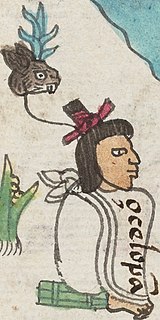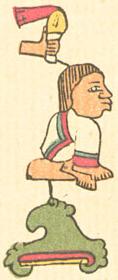
Axayacatl was the sixth tlatoani of the altepetl of Tenochtitlan and Emperor of the Aztec Triple Alliance.

Cuitláhuac or Cuitláhuac was the 10th Huey Tlatoani (emperor) of the Aztec city of Tenochtitlan for 80 days during the year Two Flint (1520). He is credited with leading the resistance to the Spanish and Tlaxcalteca conquest of the Mexica Empire, following the death of his kinsman Moctezuma II.

Cuauhtémoc, also known as Cuauhtemotzín, Guatimozín, or Guatémoc, was the Aztec ruler (tlatoani) of Tenochtitlan from 1520 to 1521, making him the last Aztec Emperor. The name Cuauhtemōc means "one who has descended like an eagle", and is commonly rendered in English as "Descending Eagle", as in the moment when an eagle folds its wings and plummets down to strike its prey. This is a name that implies aggressiveness and determination.

Tenochtitlan, also known as Mexico-Tenochtitlan, was a large Mexica altepetl in what is now the historic center of Mexico City. The exact date of the founding of the city is unclear. The date 13 March 1325 was chosen in 1925 to celebrate the 600th anniversary of the city. The city was built on an island in what was then Lake Texcoco in the Valley of Mexico. The city was the capital of the expanding Aztec Empire in the 15th century until it was captured by the Spanish in 1521.

Tizocic[tiˈsosik] or TizocicatzinNahuatl pronunciation: [tisosiˈkat͡sin̥](listen) usually known in English as Tizoc, was the seventh tlatoani of Tenochtitlan. His name means, "He who makes sacrifices" or "He who does penance."

The Aztecs were a Mesoamerican culture that flourished in central Mexico in the post-classic period from 1300 to 1521. The Aztec peoples included different ethnic groups of central Mexico, particularly those groups who spoke the Nahuatl language and who dominated large parts of Mesoamerica from the 14th to the 16th centuries. Aztec culture was organized into city-states (altepetl), some of which joined to form alliances, political confederations, or empires. The Aztec Empire was a confederation of three city-states established in 1427: Tenochtitlan, city-state of the Mexica or Tenochca; Texcoco; and Tlacopan, previously part of the Tepanec empire, whose dominant power was Azcapotzalco. Although the term Aztecs is often narrowly restricted to the Mexica of Tenochtitlan, it is also broadly used to refer to Nahua polities or peoples of central Mexico in the prehispanic era, as well as the Spanish colonial era (1521–1821). The definitions of Aztec and Aztecs have long been the topic of scholarly discussion ever since German scientist Alexander von Humboldt established its common usage in the early nineteenth century.
Tlatoani is the Classical Nahuatl term for the ruler of an āltepētl, a pre-Hispanic state. It is the noun form of the verb "tlahtoa" meaning "speak, command, rule." As a result, it has been variously translated in English as "king," "ruler," or "speaker" in the political sense. Above a tlahtoani is the Hueyi Tlahtoani, sometimes translated as "Great Speaker," though more usually as "Emperor". A cihuātlahtoāni is a female ruler, or queen regnant.

Don Diego de Alvarado Huanitzin was a 16th-century Nahua noble. A grandson of Axayacatl, Nephew of tlatoani Moctezuma II. He was initially the tlatoani (ruler) of Ecatepec before becoming tlatoani of Tenochtitlan, as well as its first governor under the colonial Spanish system of government.

The Aztecs were a Pre-Columbian Mesoamerican people of central Mexico in the 14th, 15th, and 16th centuries. They called themselves Mēxihcah.
Tezozomoctzin was a son of Itzcoatl, the fourth Aztec ruler (tlatoani) of Tenochtitlan.

Acacitli was a Mexica chief and one of the "founding fathers" of Tenochtitlan, the capital of the Aztec Empire.

Xilomantzin was the tlatoani ("king") of the pre-Columbian altepetl of Culhuacan in the Valley of Mexico from 1440 to 1473.

The Mexica, or Mexicas, were a Nahuatl-speaking indigenous people of the Valley of Mexico who were the rulers of the Aztec Empire. They were the last Nahua-speaking immigrants to enter the Basin of Mexico after the decline of the Toltecs. The group was also known as the Culhua-Mexica in recognition of its kinship alliance with the neighboring Culhua, descendants of the revered Toltecs, who occupied the Toltec capital of Tula from the 10th to the 12th centuries. The Mexica of Tenochtitlan were additionally referred to as the "Tenochca," a term associated with the name of their altepetl (city-state), Tenochtitlan, and Tenochtitlan's founding leader, Tenoch. The Mexica established Mexico Tenochtitlan, a settlement on an island in Lake Texcoco. A dissident group in Mexico-Tenochtitlan separated and founded the settlement of Mexico-Tlatelolco with its own dynastic lineage. The Mexica of Tlatelolco were also known as Tlatelolca.

The Battle of Tlatelolco was fought between the two pre-Hispanic altepetls Tenochtitlan and Tlatelolco, two independent polities which inhabited the island of Lake Texcoco in the Basin of Mexico.
Cuāuhtlahtoāni or Cuäuhtlahtoh is a titular office of governorship and political administration, used within certain city-states and provinces among the Aztecs of pre-Columbian central Mexico in the Late Postclassic period. The office of cuauhtlatoani carried the connotation of "military ruler" or "appointed administrator". During the rise of the Aztec Empire the title was given by the ruling Mexica-Tenochca to the governors they imposed on conquered city-states in central provinces.

Tlatelolco was a pre-Columbian altepetl, or city-state, in the Valley of Mexico. Its inhabitants, known as the Tlatelolca, were part of the Mexica, a Nahuatl-speaking people who arrived in what is now central Mexico in the 13th century. The Mexica settled on an island in Lake Texcoco and founded the altepetl of Mexico-Tenochtitlan on the southern portion of the island. In 1337, a group of dissident Mexica broke away from the Tenochca leadership in Tenochtitlan and founded Mexico-Tlatelolco on the northern portion of the island. Tenochtitlan was closely tied with its sister city, which was largely dependent on the market of Tlatelolco, the most important site of commerce in the area.

Tenayuca is a pre-Columbian Mesoamerican archaeological site in the Valley of Mexico. In the Postclassic period of Mesoamerican chronology, Tenayuca was a settlement on the former shoreline of the western arm of Lake Texcoco. It was located approximately 10 kilometres (6.2 mi) to the northwest of Tenochtitlan.

Tlatelolco is an archaeological excavation site in Mexico City, Mexico where remains of the pre-Columbian city-state of the same name have been found. It is centered on the Plaza de las Tres Culturas. On one side of the square is this excavated Tlatelolco site, on a second is the oldest European school of higher learning in the Americas called the Colegio de Santa Cruz de Tlatelolco, and on the third stands a mid-20th-century modern office complex, formerly housing the Mexican Foreign Ministry, and since 2005 used as the Centro Cultural Universitario of UNAM.
Chalchiuhnenetzin was an Aztec princess of Tenochtitlan, and a Queen consort of Tlatelolco by marriage to Moquihuix of Tlatelolco. She is foremost known in history for the famous legends about her lovers.

Chimalpilli II was a Tlatoani (ruler) of the Nahua altepetl (city-state) Ecatepec, in 16th-century Mesoamerica.
















